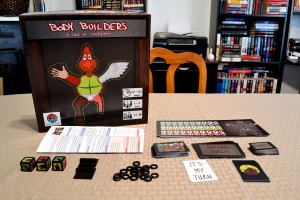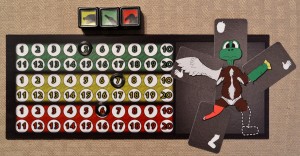This is admittedly a first…never before have I assumed the role of a taxidermist in any of the games I’ve played. “Body Builders: A Tale of Taxidermy”, a game that just hit the virtual shelves on “The Game Crafter” (link below), promises exactly that. In this particular case, each player is a lonely taxidermist who is aiming to create a friend for themselves…nothing out of the ordinary there. Before we go mashing things together, I’d like to quickly thank Brian Henk from Nevermade Games for reaching out and providing me with a press copy. It’s important to stress that I received the press copy before the game officially launched on “The Game Crafter” on 11/25/13, so the components featured below may or may not be representative of the final product.
“Body Builders: A Tale of Taxidermy”, to sum it up, tasks players with using scavengers (hyenas, crocodiles, and vultures) to collect scraps, which in turn are combined into animal parts. With these animal parts, players will be assembling their “friend” on their own individual game mat. The mat itself contains an outline of the humanoid, allowing players to easily assemble their new-found companion in an organized fashion. The game comes with a number of animal part cards (enough for five complete sets).
Of course, there’s more than just collecting animal parts with scavengers and assembling them on your player mat. The game includes recruiting dice, which have pictures of the three scavengers you’ll be utilizing to collect the animal parts. You see, you’ll actually be keeping track of how many of each scavenger you have via a scavenger mat…this consists of three separate trackers ranging from one to twenty. There will be a lot of numbers flying around when the game gets down and dirty, though invasion/natural forces cards exist to help add a luck factor to the game so that there aren’t any runaway leaders.
Why are players collecting an army of these three scavengers? While half the game is about collecting scraps to create animal parts, there’s heavy emphasis on combat in the form of invasions. Invasions allow you to steal animal parts from your opponents outright, without having to go through the process of collecting and trading in scrap cards. There’s half a page in the manual dedicated to invasions, but it can be simplified to say that whoever has more scavengers of the chosen type will win the conflict. Players will lose scavengers as these invasions occur, so choosing which of your three armies to upkeep during the recruiting phase adds a bit of strategy to the gameplay.
To put all of the above together, a game turn consists of three main phases: 1) Recruiting Scavengers, 2) Invading, and 3) Moving Markers. At the beginning of the first phase, everyone will roll to recruit scavengers regardless of whose turn it is. Players are free to choose the “value” of the first die, but must roll the second and third. Once players have adjusted the rings on their individual scavenger trackers, they’ll also be allowed to claim and exchange scrap cards. Phase two (invading) is for the current player only, who gets to choose an opponent to invade. An invasion/natural forces card is drawn and the invasion is resolved. Finally, the “It’s My Turn” and “Poacher” markers are moved to other players appropriately during phase three.
Of course, that’s simply a quick rundown of the rules. There’s plenty I didn’t cover, like how the weakest player will have the “poacher” ability via the poacher marker. This allows the player to both destroy scavengers belonging to another player and/or double the number of scavengers recruited during a roll. I personally enjoyed this mechanic, as it prevents anyone from falling behind to the point where they stand no chance of winning the game. Speaking of which, the first player to completely fill their player mat with parts (which can be mix-matched from different animals), wins the game.
For those of you who have kids or grandkids, you needn’t worry about the game being gory or bloody. It’s all very cartoony…think “Mr. Potato Head” but with more in-depth gameplay. Still, there are cards that feature various animal parts and corpses, so parental guidance is suggested. Adults who have a strong opinion about taxidermy or kids too young to understand the difference between a game and real life may be disturbed by some of the cards. On a personal level, I was fine with letting the kids play despite the fact that I’m an animal lover.
Overall, we had a pretty good time with “Body Builders: A Tale of Taxidermy”. I’ll say this, it’s certainly a unique idea. We play test and review so many games that sometimes they have a tendency to blend together…one worker placement game feels like the next, tabletop 4x games begin to feel like more of the same, and etc. We didn’t have that problem with this particular game…far from it. I also appreciated the focus the gameplay gave to balancing that game out for anyone on the losing side of the scale. This can make the current loser feel much more powerful than the others and get them right back into the game as a result. All in all, “Body Builders: A Tale of Taxidermy” is one little gem that you won’t want to pass up.
—
You can learn more about and purchase “Body Builders: A Tale of Taxidermy” by visiting the following websites:
https://www.thegamecrafter.com/games/body-builders:-a-tale-of-taxidermy
—


